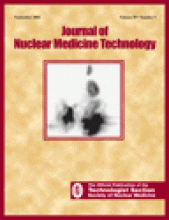Abstract
Previous reports have shown that 99mTc-sestamibi (MIBI) could detect clinically occult metastatic melanoma lesions. This article reports on a patient with invasive melanoma of the right heel in whom the sentinel node status was preoperatively evaluated with this tracer. Although regional lymph nodes were clinically negative, 99mTc-MIBI scintigraphy showed focal increased tracer uptake in the right groin that corresponded to the location of 2 sentinel nodes visualized by lymphoscintigraphy with 99mTc-colloidal rhenium sulfide performed the same day. A γ-probe was used intraoperatively to guide the excision of the sentinel nodes that were further classified as metastatic by histopathology. This double-technique approach is technically feasible and has the potential of selecting a group of patients who might benefit from a selective complete lymphadenectomy.
Sentinel node (SN) status has been shown recently to be the strongest independent prognostic factor for melanoma stage I–II patients (1). Preoperative lymphoscintigraphy and intraoperative mapping with γ-detecting probes offer simple and reliable methods of guiding SN biopsy (2,3). This procedure allows for a detailed histopathologic evaluation involving multiple sections, hematoxylin, and eosin staining in combination with immunohistochemical studies of the nodes with the highest chance of containing metastatic foci. However, the mentioned staging strategy is cost and labor intensive. For that reason, diagnostic noninvasive procedures that provide accurate preoperative assessment of the SN are of clinical interest.
99mTc-sestamibi (MIBI) has been postulated as an effective imaging agent for the detection of melanoma lesions (4–6). Therefore, we report the evaluation of the SN status in a melanoma patient using 2 preoperative radionuclide techniques: 99mTc-MIBI scintigraphy and lymphoscintigraphy with 99mTc-colloidal rhenium sulfide.
CASE REPORT
A 61-y-old woman with skin phototype III presented with an 18-mo history of a pigmented lesion of the right heel without clinical evidence of metastatic disease in regional lymph nodes. She was entered into a research protocol to preoperatively investigate the use of 99mTc-MIBI uptake in the SN. For this purpose, 740 MBq of this tracer were intravenously injected the day before surgery. Planar imaging of the inguinal region was performed 10 min after injection using a large-field-of-view rectangular gamma camera (Sophy DSX; Sopha Medical, Buc, France) fitted with a low-energy, high-resolution collimator. The same day, without moving the patient from the imaging table, a lymphoscintigraphy study was acquired 40 min after MIBI scanning. A dose of 130 MBq 99mTc-colloidal rhenium sulfide (Nanocis; CIS bio international, Gif-Sur-Yvette, France) was intradermally administered around the primary lesion to identify lymphatic basins at risk for metastatic disease and to determine the location of the SN in relation to the rest of the lymphatic basin to direct the surgical incision. Scanning of regional lymph nodes was immediately performed in the same camera using 5-min consecutive planar images. Sentinel nodes were identified in the scans and marked in the groin with the help of a 57Co penmarker. Overlying intradermal tattoos were performed according to the previous marks after being checked in the skin surface with a handheld γ-probe (Gammed II; Eurorad, Strasbourg, France). The probe was used intraoperatively to again locate the SN. Once the SN had been excised and the radioactivity of the SN confirmed, the lymphatic basin was checked for any remaining radioactivity above the surrounding tissue background.
99mTc-MIBI scintigraphy showed focal increased tracer uptake in the right groin (Fig. 1), which corresponded to the location of the 2 SNs visualized by lymphoscintigraphy (Fig. 2). Two lymph nodes were excised and considered as SNs. The postsurgical histopathologic report confirmed the clinical diagnosis of primary invasive melanoma, Clark IV, Breslow 2.0 mm. Furthermore, the hematoxylin and eosin stain revealed subcapsular metastatic cells in both SNs.
99mTc-MIBI image showing increased tracer uptake in right groin (arrow).
Lymphoscintigram of same patient performed with 99mTc-colloidal rhenium sulfide shows 2 sentinel lymph nodes in right inguinal region (arrowheads) in same location as focal area of 99mTc-MIBI uptake. Histopathology revealed metastatic cells in both nodes.
DISCUSSION
Lymphatic mapping, sentinel lymphadenectomy, and selective complete lymph node dissection are considered options in the standard therapy of early-stage melanoma (7,8). This approach offers a minimally invasive method for patients who actually have stage III disease, who are more likely to relapse at distant sites, and who may therefore benefit from adjuvant therapies. However, controversy still exists regarding technical aspects of the procedure, its role outside high-volume melanoma centers, and the clinical significance of occult metastases in the SN (9). Moreover, the therapeutic implication of SN biopsy awaits further follow-up data from multiinstitutional studies.
Our initial clinical experience with a series of 82 melanoma patients revealed that 99mTc-MIBI scintigraphy is a highly accurate technique (92% sensitivity, 96% specificity) for the detection of clinically evident and occult metastatic melanoma lesions in different tissues (10,11), confirming the results of a previous study reported by Soler et al. (12).
CONCLUSION
The clinical value of the preoperative evaluation of 99mTc-MIBI uptake in SN in patients with melanoma needs further investigation. This double-technique approach is technically feasible and has the potential for selecting a group of patients who might benefit from a selective complete lymphadenectomy without first performing an SN biopsy.
Acknowledgments
This work was supported in part by the Comisión Honoraria de Lucha Contra el Cáncer in Montevideo, Uruguay.
Footnotes
For correspondence or reprints contact: Omar Alonso, CNMT, MD, Hospital de Clínicas, Centro de Medicina Nuclear, Avda. Italia s/n, Montevideo 11600, Uruguay; Phone: 598-2-487 1407; Fax: 598-2-487 3182; E-mail: oalonso{at}hc.edu.uy.









